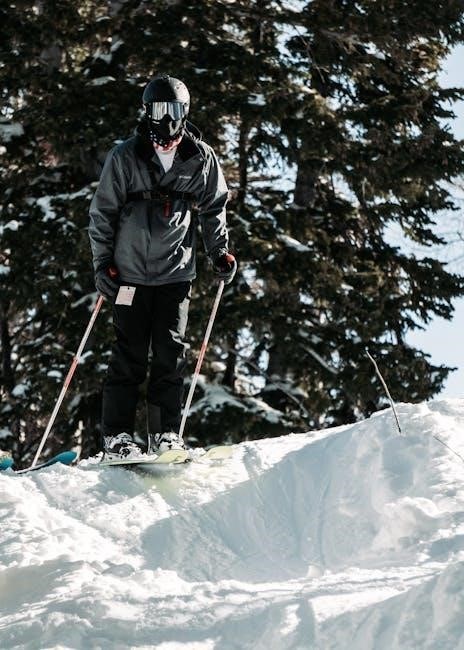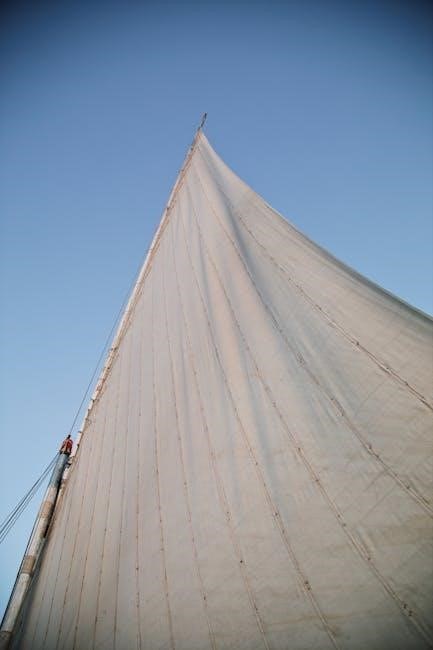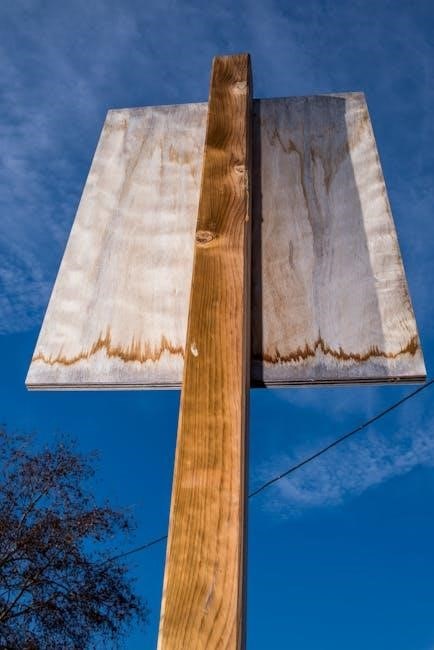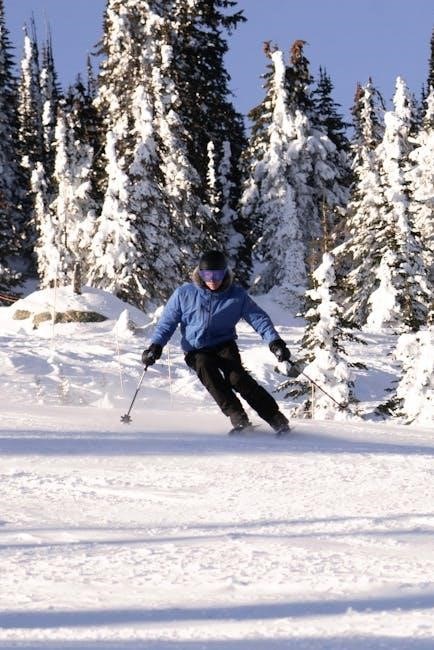
ski pole length guide
Choosing the right ski pole length is essential for optimal performance, balance, and mobility on the slopes. This guide provides expert tips and sizing recommendations to help skiers of all levels find the perfect fit, ensuring comfort and efficiency across various skiing disciplines and terrains.
Importance of Proper Ski Pole Length
Proper ski pole length is crucial for maximizing performance, comfort, and control on the slopes; Incorrectly sized poles can lead to poor technique, fatigue, and reduced maneuverability. Too short, and you may struggle with balance; too long, and your movement becomes restricted. The right length ensures efficient energy use, better grip on the snow, and smoother transitions between turns. It also helps maintain proper posture, reducing the risk of injury. Whether you’re carving down groomed trails or exploring off-piste terrain, optimal pole length is key to enhancing your skiing experience and skill development. This guide helps you understand why proper sizing matters and how to achieve it.
Brief Overview of Ski Pole Sizing
Ski pole sizing is primarily determined by a skier’s height and the type of skiing they will be doing. A general rule of thumb is to use a height-to-pole-length ratio, where pole length is approximately 70-85% of the skier’s height in centimeters. For example, a 170 cm tall skier might use poles around 120-145 cm. However, this can vary based on skiing style, terrain, and personal preference. Adjustable poles offer flexibility for different conditions, while fixed-length poles provide optimal performance for specific disciplines. Proper sizing ensures efficient movement, better control, and reduced fatigue. This overview provides a foundational understanding, with detailed adjustments covered in subsequent sections.

Ski Pole Sizing Chart
Our ski pole sizing chart provides a quick reference guide, correlating skier height with recommended pole lengths. Use the chart to find your ideal size easily.
Standard Height-to-Pole-Length Chart
A standard height-to-pole-length chart provides a straightforward guide to determining the ideal ski pole length based on a skier’s height. For skiers measuring 67 inches or taller, a 56-inch pole is typically recommended, while shorter skiers may require poles ranging from 48 to 54 inches. The chart serves as a baseline, but adjustments can be made based on personal preference, skiing style, and terrain. To ensure accuracy, skiers can use a tape measure or the 90-degree elbow test, where the pole is held upside down, and the arm forms a right angle. This method ensures proper fit and optimal performance on the slopes.
Adjustments Based on Skiing Style and Terrain
Adjusting ski pole length based on skiing style and terrain ensures optimal performance and comfort. Cross-country skiers often prefer longer poles for increased propulsion, while downhill skiers may opt for shorter poles to improve maneuverability. For backcountry or deep snow conditions, longer poles can enhance stability and leverage. Terrain-specific adjustments also apply: shorter poles are better for tight spaces or park skiing, while longer poles suit open trails or flat terrains. Personal preference plays a role, as some skiers prefer a more upright stance, while others favor a slight forward lean. Always test adjustments on the snow to ensure the chosen length complements your technique and terrain preferences.
The Angle Rule for Ski Pole Length
Flip the ski pole upside down, grip it below the basket, and stand with your elbow at a 90-degree angle. Adjust the length so your forearm is level with the ground; if the angle is too narrow or wide, the pole needs resizing for proper fit and performance.
Step-by-Step Guide to the 90-Degree Elbow Test
To perform the 90-degree elbow test, stand upright and hold a ski pole upside down, gripping it just below the basket. Ensure you’re wearing your ski boots for accurate sizing. Your arm should naturally form a right angle at the elbow, with your forearm parallel to the ground. If your elbow bends more than 90 degrees, the pole is too short, and if it bends less, the pole is too long. This method ensures optimal balance and control, allowing for efficient skiing. Adjust the pole length as needed until the angle feels comfortable and natural, ensuring a proper fit for your skiing style and terrain.

Skiing Discipline and Pole Length
Skiing discipline and terrain significantly influence pole length, with cross-country skiing requiring longer poles for propulsion, while downhill skiing uses shorter poles for maneuverability and control.
Cross-Country Skiing Pole Length Recommendations
Cross-country skiing requires longer poles to maximize propulsion and efficiency. Typically, pole length is determined by the skier’s height, with a general recommendation of 70-80% of the skier’s height in centimeters. For example, a skier measuring 170 cm should use poles around 119-136 cm. This longer length allows for an effective stride and better power transfer during the skating technique. Additionally, adjustable telescopic poles are ideal for varying terrain and personal preference. Proper fit ensures elbows form a 90-degree angle when holding the poles, optimizing balance and performance. Always consider skiing style and terrain when selecting cross-country poles for the best experience.
Downhill and freestyle skiing require shorter poles compared to cross-country, focusing on maneuverability and control. For downhill skiing, poles are typically 45-55 inches, allowing quick turns and balance. Freestyle skiers opt for even shorter poles, around 42-48 inches, to prevent interference during tricks and flips. The shorter length enhances agility and reduces the risk of poles getting caught in obstacles. Proper fit is crucial, with elbows forming a 90-degree angle when gripping the pole. Adjustable poles are beneficial for adapting to changing conditions or styles. Choosing the right length ensures better performance, safety, and confidence on the slopes, catering to the dynamic needs of these disciplines.

Additional Considerations
Downhill and Freestyle Skiing Pole Length Differences
Downhill skiing typically uses shorter poles than cross-country, with lengths ranging from 45 to 55 inches, designed for quick turns and balance. Freestyle skiing requires even shorter poles, around 42 to 48 inches, to avoid interference during tricks and flips. The shorter length enhances agility and reduces the risk of poles getting caught in obstacles. Proper fit is crucial, ensuring elbows form a 90-degree angle when gripping the pole. Adjustable poles are beneficial for adapting to changing conditions or styles. Choosing the right length is essential for better performance, safety, and confidence on the slopes, catering to the dynamic needs of these disciplines.
Adjustable vs. Fixed-Length Ski Poles
Adjustable ski poles offer flexibility, allowing customization to suit various skiing conditions or terrains, which can be beneficial for backcountry adventures. They are also advantageous for sharing equipment among different users, as their length can be tailored to individual preferences. However, adjustable poles may be heavier due to the additional mechanisms and could be more expensive. On the other hand, fixed-length poles are typically lighter, more durable, and cost-effective, making them ideal for those with consistent skiing styles. While they lack the adaptability of adjustable poles, they often provide optimal performance for specific skiing disciplines. The choice between the two ultimately depends on personal skiing needs, preferences, and the types of terrains encountered.
Personal Preference and Flexibility in Pole Length
While standard sizing charts provide a baseline, personal preference plays a significant role in determining the ideal ski pole length. Some skiers prefer slightly longer poles for added stability, while others opt for shorter poles to enhance agility and maneuverability.Terrain and skiing style also influence preferences, as deeper snow or unique techniques may require adjustments. Adjustable poles offer flexibility, allowing skiers to customize their setup for varying conditions. Ultimately, the right pole length is one that feels comfortable and aligns with individual skiing goals, ensuring optimal performance and enjoyment on the slopes. Balancing personal comfort with practicality is key to making the best choice.

Final Tips for Choosing the Right Ski Pole Length
When selecting ski poles, prioritize proper fit by using the 90-degree elbow test and consulting a sizing chart tailored to your height and skiing style. Consider adjustable poles for versatility across different terrains and techniques. Remember, personal preference matters—experiment with lengths to find what feels most comfortable and enhances your performance. Always test poles while wearing ski boots, as they add height. For cross-country skiing, longer poles may be beneficial, while downhill skiing often requires shorter lengths. Lastly, seek professional advice if unsure, and ensure your poles match your skiing discipline for optimal results. A well-chosen pole length can significantly improve your skiing experience and overall enjoyment on the slopes.